
Design Checklist has been updated as of October 2020. In this fast changing world, we expect this list to continue to change, and we will update accordingly.
The attendee experience in both digital and physical platforms has changed. Now more than ever, it is important that we redefine what creative means to events, and the approach we take, to create engaging experiences that connect us, even when we can’t be together.
In our recent webinar, Executive Creative Director, Hillary Smith, and Regional Creative Director, Ashley Yuknus, were joined by Mark Ledogar, President of One Smooth Stone, to discuss these changes and how, by using a Design Thinking Process, we can tap into the mindset of the attendee to create an experience they will value at face-to-face events.
We invite you to view the full webinar and the below list of tactical considerations to gain the trust of the future attendee. Our current world is constantly changing, and so will this list. But our collective knowledge sharing will lead us to the future we will craft together.
PRE-EVENT
Start by re-evaluating the purpose of the meeting. Take into consideration any new messages or business objectives, and approach planning with your “attendee” hat on. Keep in mind, the success of the meeting will depend on your ability to make guests feel safe and comfortable.
When you think of the attendee, consider changes to physical attendance (are they more local or regional now?), as well as the size of the group. This will alter how you will connect and engage with them. They need to trust that you’ve thought through their experience and have put their health and safety first.
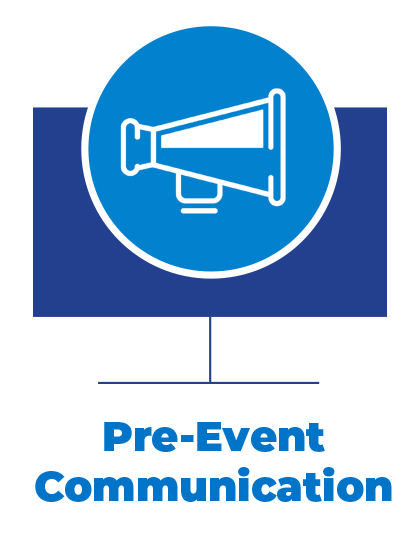
Pre-Event Communication
- Start with transparency in all pre-event communications to relay health and safety measures being taken at the conference
- Are you able to cover the costs of health screenings or flu shots prior to meetings?
- Can you send a kit including antibacterial wipes, hand sanitizer, masks, gloves, travel size Lysol spray, etc. before attendees travel? Bonus opportunity for customization!
- Make sure attendees are aware of new meeting etiquette such as refraining from hugging, hand shaking or high-fives and the need to leave space between each other
- Can you come up with alternative greetings that are reflective of your unique culture and people?
- Host a contest to see who can re-invent your company’s greeting
- Ensure onsite signage reinforces and highlights the change in behavior
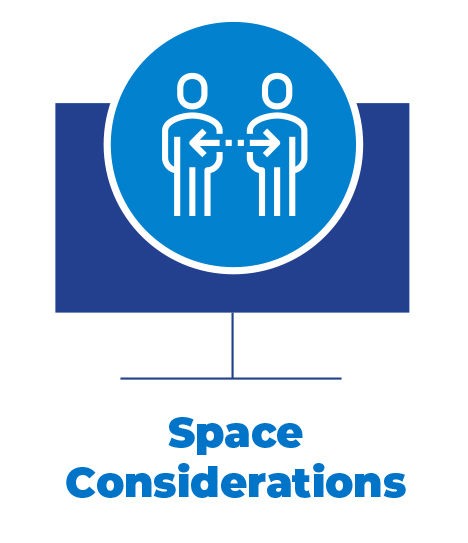
Space Considerations
- What is your audience’s expectations on personal space? Have you adjusted based on any social distancing limitations or recommendations?
- Review your original contract to ensure that you have enough space based on new ratios
- How have the norms of networking impacted the flow and footprint of your event setting?
- Is a group cocktail reception or welcome reception still the right call?
- Does the hotel have ample bandwidth for any web broadcast or digital/virtual component that may now be necessary?
- Can your hotel partner work with you on sanitizing rooms, increasing air filtration or providing complimentary “travel clothes” cleaning? What have they put in place to ensure the safety of your guests?
- For meal functions (in the right climates) consider moving meals outdoors or overflowing with outdoor seating so guests can get fresh air
- Provide hand sanitizers at every entrance
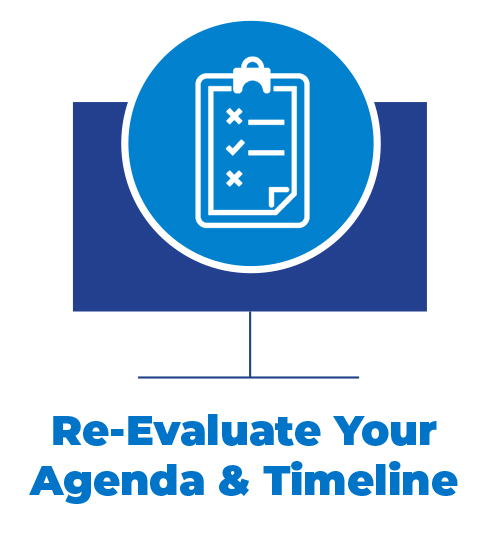
Re-Evaluate Your Agenda and Timeline
- Stagger groups to avoid queue lines or unnecessary bottleneck. Organize groups by their last name and control the flow for arrival to organized functions
- Consider offering multiple and/or separate registration areas
- Ensure that your run of show timelines have time built in for necessary sanitation services by the hotel and all suppliers. This is an extra step and will require additional labor and cost
- Depending on the air movement within the space, consider building in more or extended breaks so guests can get out and get fresh air
PHYSICAL DESIGN
It’s important to consider guests have been at home for weeks in a secure, comfortable environment. How can we bring that same feeling into the meeting spaces? Utilize lighting, residential seating, accents and bookshelves. Taking an utilitarianism approach for the greater good of the attendees, the focus should be on function before aesthetics. This shift requires new floor diagrams planning much earlier in the process.
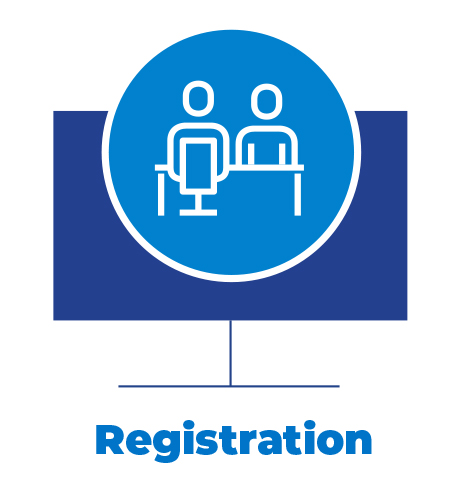
Registration
- Increase the number of desks and staff, all properly outfitted for safety concerns
- Consider installing clear plexiglass between the onsite registration staff and guests at check in locations
- Use floor decals to ensure proper social distancing with 6-foot spacing
- If you are considering kiosks or contactless products in lieu of live registration staff, remember guests will be physically touching these units and units will require frequent cleaning
- Offer cellphone sterilization stations
- Will there be a nurse onsite to screen temperatures or new RFID technology to read temperatures as guests arrive? Once the supply is there, can you provide onsite COVID testing/vaccines?
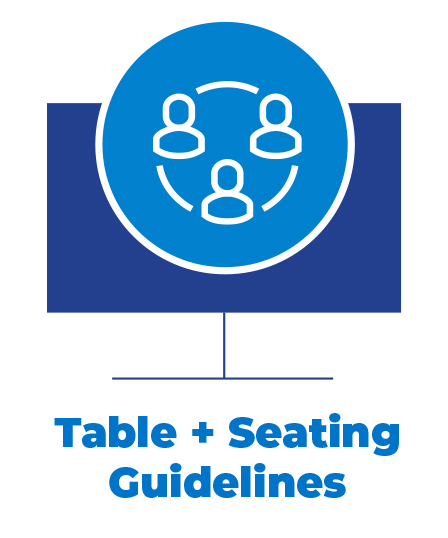
Table + Seating Guidelines
Each city, county or other governing body may have different guidelines to adhere to, but overall, consider 4-6 feet per person as you plan your spaces instead of industry standard 2 feet. Currently, we are recommending the below parameters for clients:
- Rectangular communal tables (raised or dining height)
- 6ft: 4 per table (1 on each side, including short ends)
- 8ft: 6 per table (2 on each side, 1 at each short end)
- Rounds
- 72” round: 6 per table (full seating)
- 66″ round: 5 per table (full seating)
- 60” round: 4 per table (full seating)
- No seated cocktail rounds are recommended at group functions in the near term
- For classroom seating
- 6’x18”: 1 per table
- 8’x18”: 2 per table
- Tip: If budget allows, consider offering wider club chairs w/swivel desktops and placing them 4-6′ apart in the room
- Theater-style seating
- If using ballroom chairs, start with separating chairs 4-6′ apart
- Tip: Using wider, more comfortable club chairs will provide a more comfortable and residential environment
- Use Highboy tables for standing/perching only in lieu of offering stools
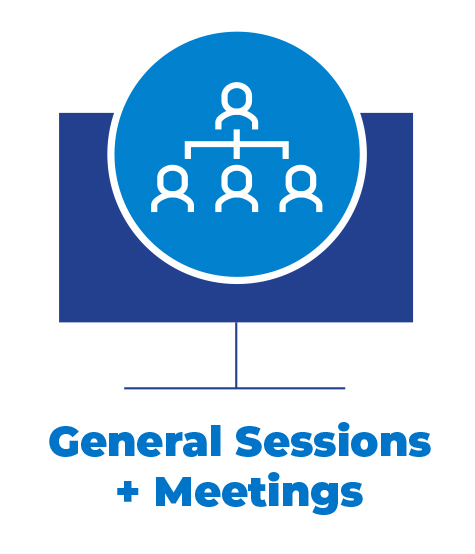
General Session/Meetings
- Increase the number and width of aisles
- Decline pre-set items such as pens and pads and forego communal sharing vessels, including candy dishes and water pitchers
- Add areas for additional guest space with highboys and communal tables around the perimeter of the room
- Include supplies on the tables for surfaces to be wiped down in the moment
- Incorporate sanitation into the design wherever you can to help ease guests’ minds
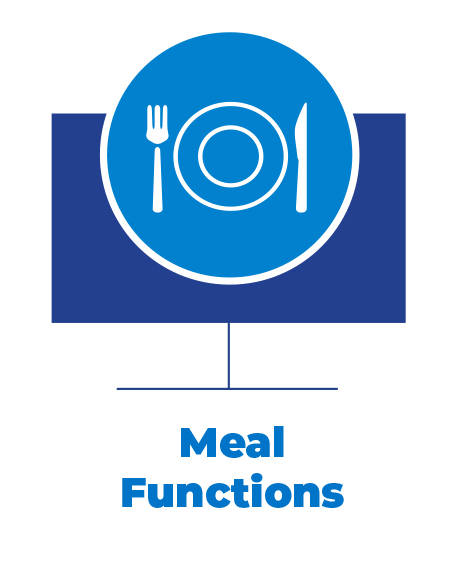
Meal Functions
- Breakfast & Lunches
- Offer boxed and pre-plated options for takeaway dining
- Stagger the breakfast times for guests to minimize groups
- Offer multiple dining area options vs. one group meal space
- Evening Dinner Functions
- Consider dine-arounds to support local businesses or use onsite hotel outlets to help control group size
- Stagger times by 15 minutes to avoid hard hit elevators filled with attendees.
- Attendees will want to avoid lines, so opt for more ancillary bars instead of center focal bars
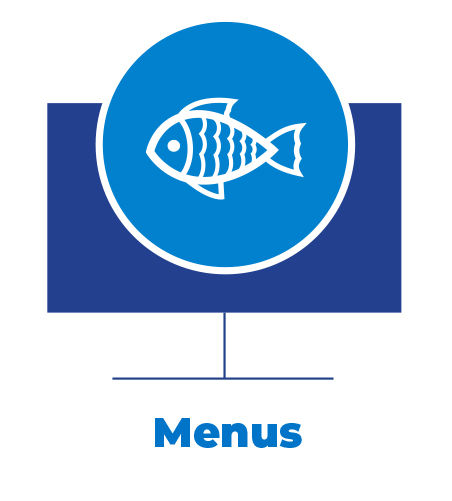
Menus
- Incorporate immune-boosting food and drink elements into the menu design
- Consider zero waste menu planning and locally sourced brands, businesses, and farmers within 250 miles
- Scale back the options being offered on menus
- Plan for plated meals or staff-served buffets
- Remove communal items like bread baskets and butter from tables
- Before opting for individual service items, consider the cost to our planet. How much waste is being created by an increase in disposable items?
THE EXPERIENCE
Networking and group behavior are changing, but still important. For your meetings, focus on creating opportunities and environments that foster connection, while ensuring guests feel comfortable that their health and safety are front of mind.
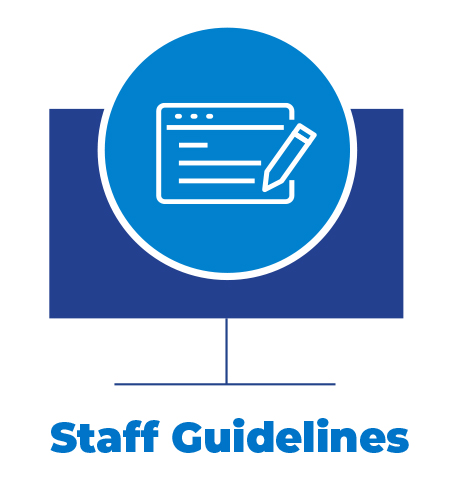
Staff Guidelines
- Take extra precautions with attendee-facing staff including health screenings, offering flu shots, sneeze guards, masks and gloves
- Don’t hide the cleaning process. It’s counter-intuitive, but showing items being sanitized will offer peace of mind
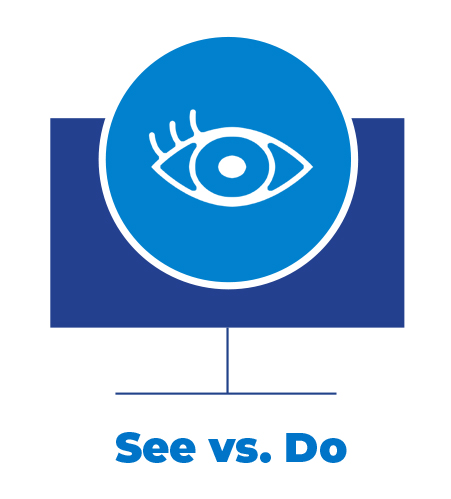
‘See’ vs ‘Do’ Experiences
- Consider smaller batch, more curated experiences for your guests to “see” instead of “do”, avoiding hand’s on options
- Create a storybook experience with one entrance and one exit, staggering groups to avoid bottlenecking. Take inspiration from:

Entertainment
- Rethink roving entertainment that relies on “up close and personal” exchanges
- Increase dance floor spacing
- Suggestions for socially distanced, shared group experiences:
- Virtual concerts can be intimate, even if the act or performer hasn’t traveled to your physical meeting. These days, we are more accepting of this and it still feels like a shared connection and experience, no matter where your groups are
- At hotels where the balconies all face a pool area, for example, consider hotel room/balcony parties with a shared concert experience below. Use drone and video, large screens and delivered meals to bring this experience to a whole new level
- Offer outdoor concerts in wide open spaces where guests can stretch out but still be entertained
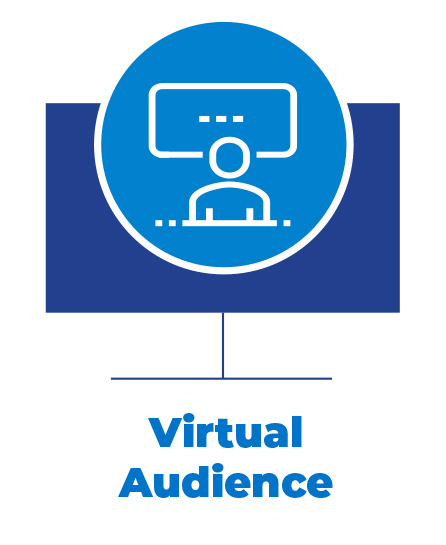
Virtual Audience
- In a hybrid setting of digital and onsite attendees, remember to incorporate design elements for the virtual audience who have lost two senses, touch and taste:
- Integrate what’s happening onsite with their virtual experience. Talk about integrated experiences for all audiences, something unique and special for the viewer at home
- Decrease the difference between the physical event experience and the experience of the audience who is participating digitally
- Create cinematic experiences using drones and more videographers
PRA is with you to help navigate what your meetings and business events of the future will look like. We hope the above recommendations, developed through the Design Thinking Process, are a good jumping off point, and we know the list will continue to develop. PRA is focusing the passionate minds and hearts of our people on finding solutions that help move our industry forward.
Reach out to Info@PRA.com to start designing your strategic approach to planning events of the future.
Have we missed anything? Please add your thoughts and comments below!

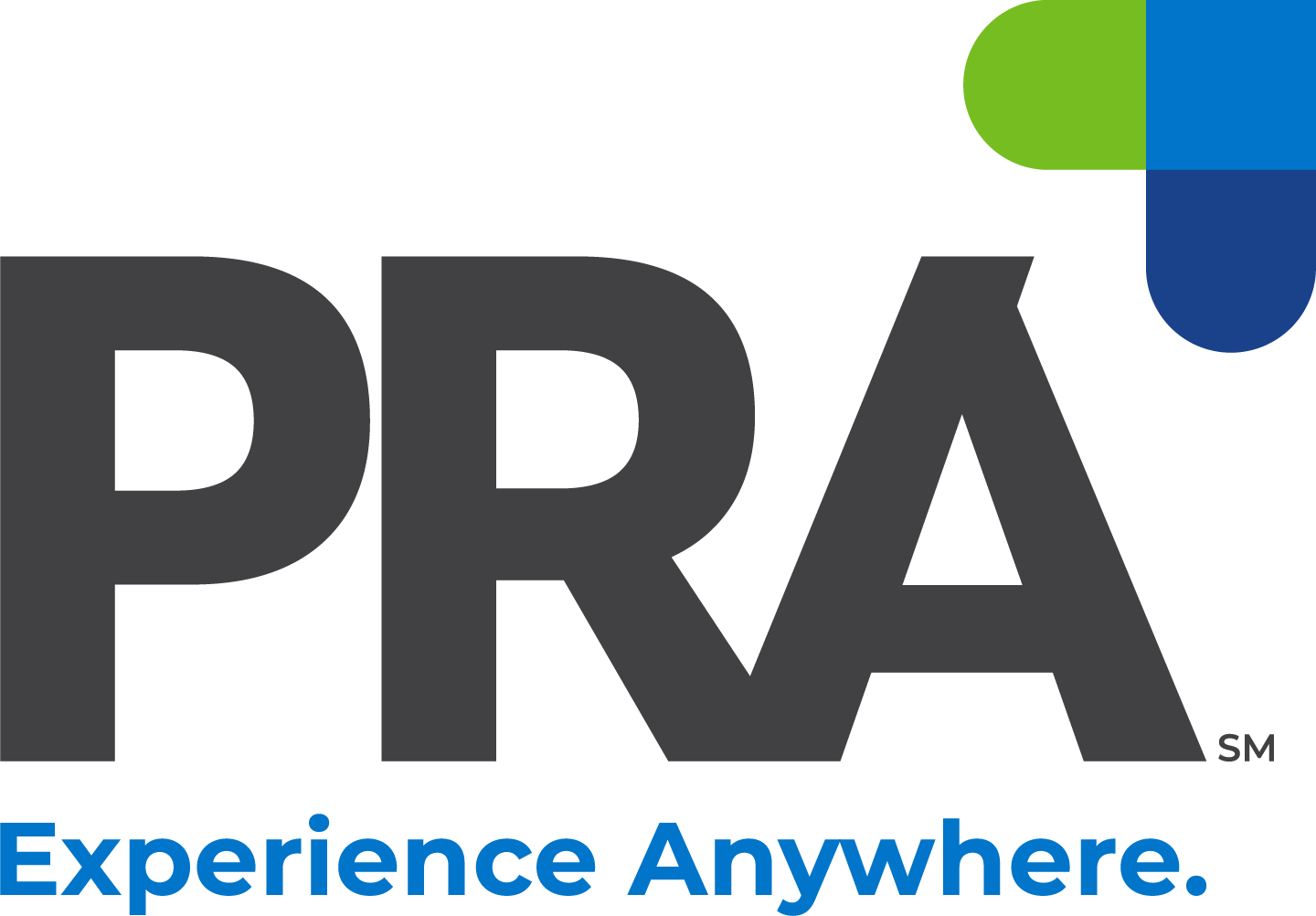


Leave A Comment